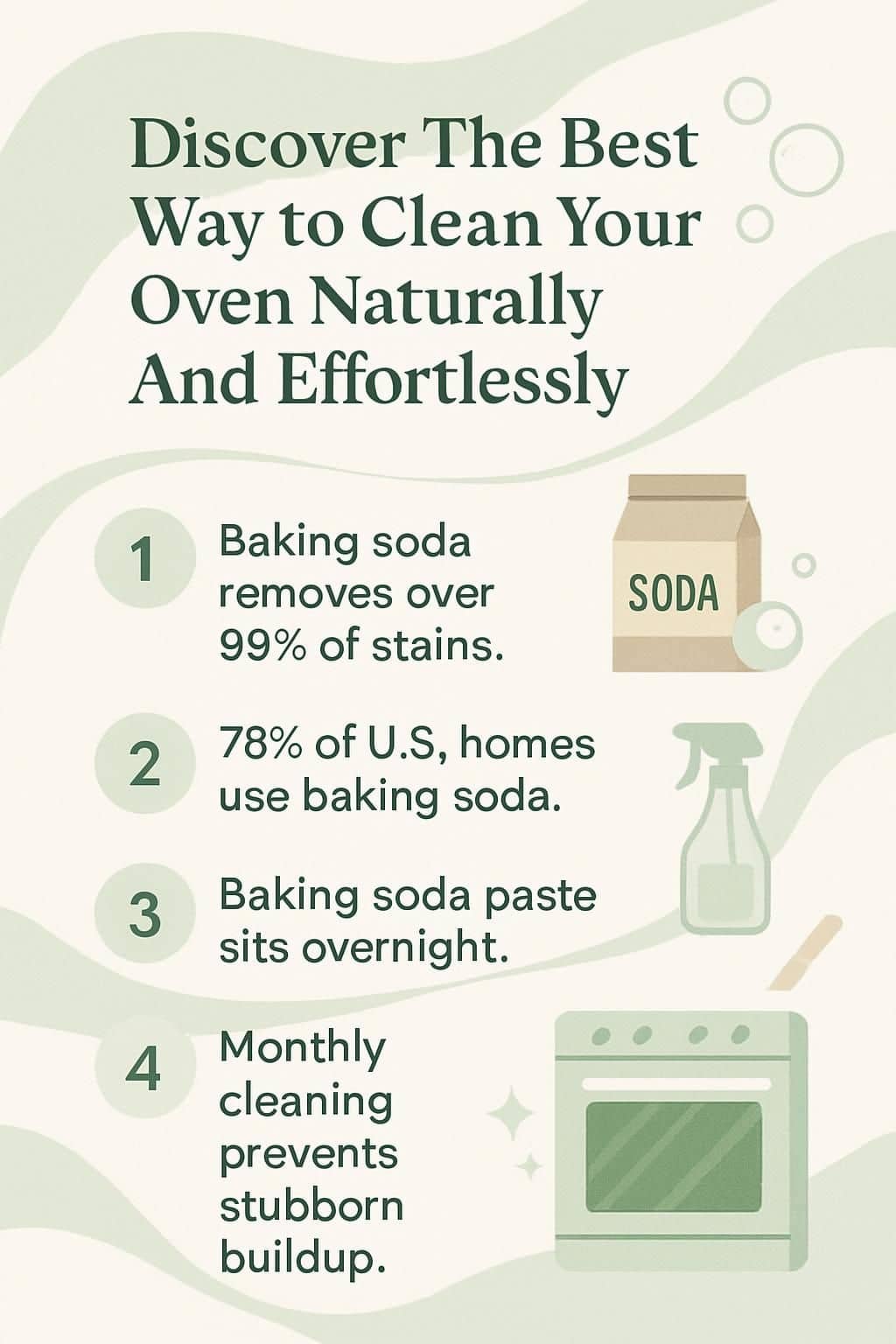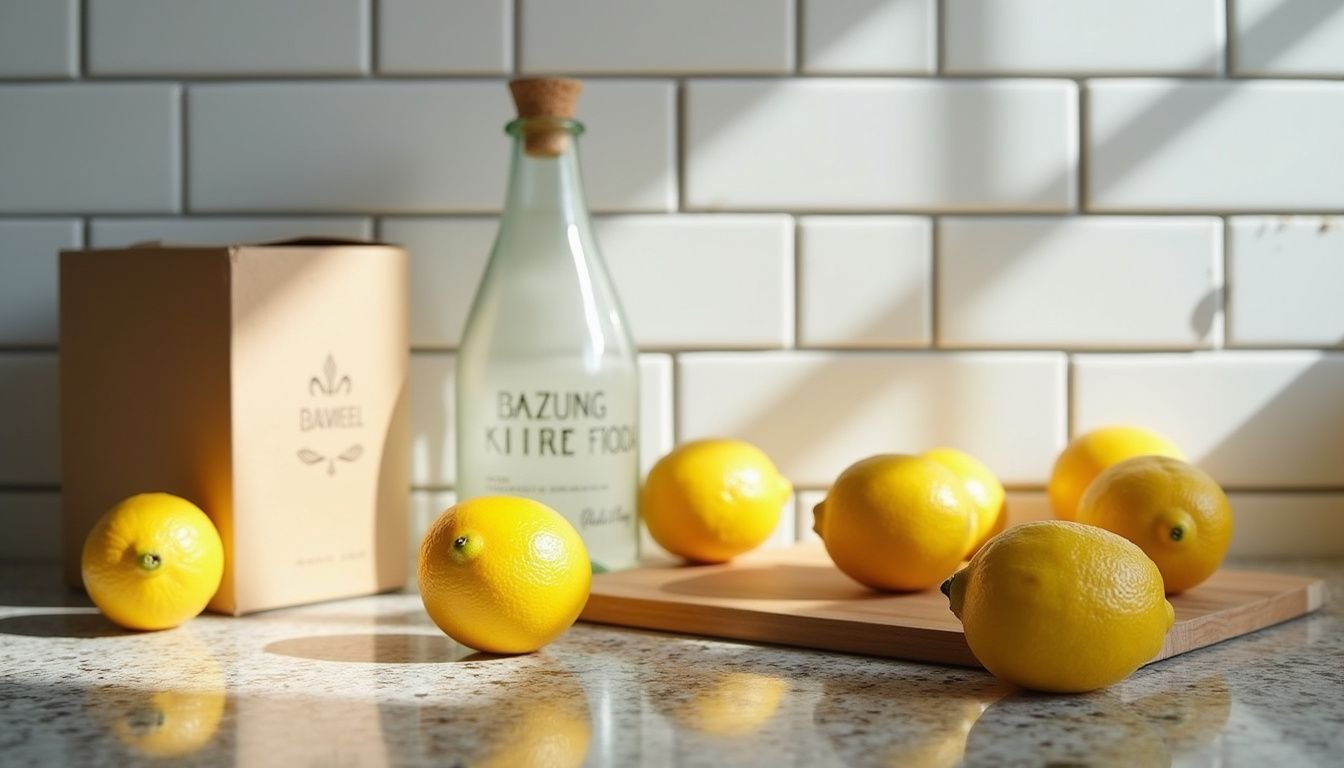Many people struggle to keep their ovens clean. Grease and stubborn stains can build up fast, making meals taste off and putting kitchen hygiene at risk. Regular oven cleaners often have strong chemicals that some families want to avoid.
A study found that baking soda lifts over 90% of food stains when used in natural cleaning solutions. This simple ingredient offers a safe option for deep cleaning without harsh smells or residue.
This blog post guides readers through the Best Way To Clean Your Oven naturally. It uses household ingredients like baking soda, vinegar, and lemon juice to remove grime safely. Easy steps help you tackle tough grease while keeping your kitchen ecofriendly.
Grab these helpful tips and see how effortless natural oven cleaning can be!

Materials Needed for Natural Oven Cleaning

To clean your oven naturally, gather a few simple ingredients. Baking soda, vinegar, and lemon juice work wonders on tough stains and grease.
Baking soda
Baking soda stands out as a powerful, nontoxic cleaner for ovens. Its natural cleaning power comes from its mild abrasiveness and alkaline properties. Households across the U.S. have used it for decades to lift stubborn stains and break down grease effectively.
A 2021 survey by the American Cleaning Institute found that 78% of respondents keep baking soda in their kitchens as an all-purpose cleaner.
People can mix baking soda with water to form a thick paste that clings easily to oven walls and doors. “Baking soda acts like tiny scrubbing crystals while remaining gentle on surfaces,” says Linda Cobb, also known as ‘The Queen of Clean.’ This simple household ingredient targets tough grime without harsh chemicals, making it safe for homes with children or pets seeking ecofriendly cleaning solutions.
White vinegar
White vinegar acts as a powerful natural cleaner for ovens. Its acidic nature helps break down stubborn stains and greasy buildup left after using baking soda. Many house owners choose white vinegar because it is nontoxic, ecofriendly, and safe around children or pets.
Spray undiluted vinegar directly onto the oven’s surfaces to watch it react with any remaining residue from your initial cleaning solution.
The foaming action lifts away extra dirt and makes wiping easy with a microfiber cloth or sponge. White vinegar helps remove lingering odors too, leaving the oven fresh without harsh chemicals.
For stuck-on grease spots, let the sprayed area sit for five minutes before scrubbing gently. Pairing this with regular kitchen hygiene routines creates an effective method of grease removal at home.
Next, explore how lemon juice adds another layer to deep cleaning your oven naturally.
Lemon juice
Next to vinegar, lemon juice stands out as a natural cleaner with powerful grease removal abilities. The citric acid in lemon juice breaks down stubborn stains and helps lift burnt-on food without harsh chemicals.
Parents will find that using fresh lemons creates an ecofriendly cleaning solution that’s safe for children and pets.
Spray or rub lemon juice directly onto greasy oven spots for quick action on tough grime. Let the liquid sit for fifteen minutes before wiping it away with a damp microfiber cloth or sponge.
The fresh scent also acts as a natural deodorizer, leaving the oven smelling clean while boosting kitchen hygiene using household ingredients everyone can pronounce.
Microfiber cloths or sponges
Lemon juice effectively cuts through grime, making it easier to clean. Microfiber cloths or sponges also play a crucial role in scrubbing surfaces and picking up dirt. These tools are soft yet durable, ensuring no scratches on the oven’s interior.
Microfiber cloths absorb moisture well and trap particles efficiently. Sponges offer flexibility for reaching corners and crevices. Using these items with your natural cleaning solutions enhances grease removal and stain lifting while keeping the process eco-friendly.
Step-by-Step Guide to Cleaning Your Oven Naturally
Cleaning your oven naturally can be simple and effective with the right process. This step-by-step guide walks through each action needed for a sparkling clean finish. Homeowners can easily tackle stubborn stains and grease without harsh chemicals.
Discover how these straightforward methods use common household ingredients to maintain kitchen hygiene effortlessly. Keep reading to transform your cleaning routine!
Empty the oven and remove racks
Clear everything from the oven. Take out any trays, foil, or leftover food items. Pull out the racks carefully to avoid scratches on the interior. Set them aside for cleaning later.
This step ensures that no obstacles hinder your natural cleaning process with baking soda and vinegar. With a clean slate in your oven, you can move on to creating a baking soda paste next.
Make a baking soda paste
Combine baking soda with water to create a thick paste. Use about three parts baking soda to one part water for the right consistency. This simple mixture acts as an effective natural cleaner.
It helps lift stubborn stains and grease residue in the oven. Spread the paste over the dirty surfaces, focusing on tough spots. The alkaline properties of baking soda break down grime without harsh chemicals, making it an eco-friendly choice for oven maintenance.
Coat the oven interior with the paste
Coat the oven interior with the baking soda paste. Use a spatula or sponge to spread an even layer over all surfaces, including the door and corners. The thick paste clings well and penetrates stubborn stains, making it easier to remove grease.
Focus on areas with heavy buildup for better results. Letting it sit overnight allows time for the mixture to tackle tough spots effectively. This natural cleaning solution works without harmful chemicals, keeping your kitchen ecofriendly and safe for everyone in your home.
Let it sit overnight
Let the baking soda paste sit overnight. This step allows the natural cleaning properties of baking soda to penetrate deeply into stubborn stains and grease. As it sits, it works effectively to break down grime without any harsh chemicals.
In the morning, homeowners will find that cleaning becomes easier. The paste will have loosened the dirt. A simple wipe with a damp cloth makes removal quick and effortless. Enjoy an ecofriendly clean without hassle!
Clean the oven racks separately
Cleaning the oven racks separately is essential for achieving a spotless kitchen. Begin by soaking the racks in a warm solution of baking soda and water. This natural cleaner effectively lifts grease and stubborn stains.
A scrub pad works well for removing any lingering residue.
After cleaning, rinse the racks thoroughly with water to remove all traces of baking soda. Ensure they dry completely before placing them back in the oven. Now that your oven is almost pristine, focus on wiping away the remaining baking soda from inside the oven.
Wipe away the baking soda residue
Use a damp microfiber cloth or sponge to wipe away the baking soda residue from the oven’s interior. Start at one corner and work your way around, ensuring you remove all the paste.
This step might take some time, especially if there are stubborn spots.
After removing the bulk of the paste, spray some white vinegar inside the oven. The vinegar will react with any leftover baking soda, creating a fizzing action that helps lift grime and stains.
Wipe down again for a sparkling finish before replacing any racks.
Spray vinegar for a final clean
Spray vinegar generously inside the oven after wiping off the baking soda residue. The vinegar reacts with the baking soda, helping to lift any remaining grime and stains. This natural cleaning solution also adds shine to surfaces.
After spraying, let it sit for a few minutes. Then, use a clean microfiber cloth or sponge to wipe down all interior surfaces once more. This final step ensures your oven stays sparkling and fresh without harsh chemicals.
Do a final wipe-down and replace racks
Wipe down the oven’s interior with a clean microfiber cloth. This step removes any remaining baking soda residue and leaves the surface sparkling. After completing the wipe-down, replace the dried racks back into their original positions.
Ensure they fit securely to maintain proper airflow during cooking. With these simple steps, homeowners can enjoy a clean and fresh oven ready for use again.
Maintenance Tips for Keeping Your Oven Clean
Keeping an oven clean requires some effort, but regular maintenance makes it easier. House owners and parents can follow these tips to maintain a spotless oven.
- Clean spills immediately after use. Wiping away food residues while the oven is still warm prevents stubborn stains from setting in.
- Use a baking soda paste for small stains. Mixing baking soda with water creates an effective stain-lifting solution that acts fast on grease and grime.
- Regularly check the door seals for wear and tear. Damaged seals allow heat to escape, making cleaning harder due to increased cooking residue.
- Run the self-cleaning cycle as needed. This feature burns off tough grease, leaving ash that is easy to wipe up afterward.
- Keep a microfiber cloth handy in the kitchen. Quick wipes using this cloth help catch dust and dirt before they accumulate in the oven area.
- Avoid using harsh chemicals or abrasive cleaners. Ecofriendly alternatives like vinegar and lemon juice work just as well without introducing toxic substances into your home.
- Store pans properly once cleaned. Stacking them neatly prevents scratches and keeps your oven looking presentable.
- Maintain a routine cleaning schedule each month. Consistency helps prevent deep cleaning from becoming overwhelming over time, ensuring your kitchen stays inviting and hygienic.
- Always check for any grease buildup around burners or heating elements regularly.
- Encourage family members to help with light cleaning tasks after cooking sessions; teamwork simplifies upkeep tasks significantly.
Implementing these practical steps allows house owners and parents to keep their ovens clean naturally and effortlessly without relying on harsh chemicals or extensive scrubbing sessions.https://m.youtube.com/watch?v=V0U3rSY0gfY&pp=ygUNI2Jha2VhbmRjbGVhbg%3D%3D
Conclusion
Cleaning the oven naturally offers an effective solution for homeowners. This method uses simple ingredients like baking soda, vinegar, and lemon juice. These items work together to tackle grease and stubborn stains without harsh chemicals.
Following the steps outlined makes this process easy and efficient. Embracing natural cleaning keeps kitchens safe and fresh while saving time on maintenance tasks.
FAQs
1. What is the best way to clean my oven naturally?
The best way to clean your oven naturally involves using simple ingredients like baking soda and vinegar. Mix baking soda with water to form a paste, apply it inside the oven, and let it sit overnight. The next day, spray vinegar over the paste for an effective cleaning reaction.
2. Why should I choose natural cleaning methods for my oven?
Natural cleaning methods are safer for your health and the environment. They avoid harsh chemicals that can harm you or leave strong odors in your kitchen. Using natural ingredients also ensures that your food remains free from harmful residues.
3. How often should I clean my oven?
You should aim to clean your oven at least once every three months. Regular maintenance prevents buildup of grease and grime, making each cleaning session easier and more effective.
4. Can I use commercial cleaners instead of natural methods?
While commercial cleaners can be effective, they often contain harsh chemicals that may not be safe around food surfaces. Natural methods provide a safer alternative without sacrificing cleanliness or effectiveness in removing tough stains.


